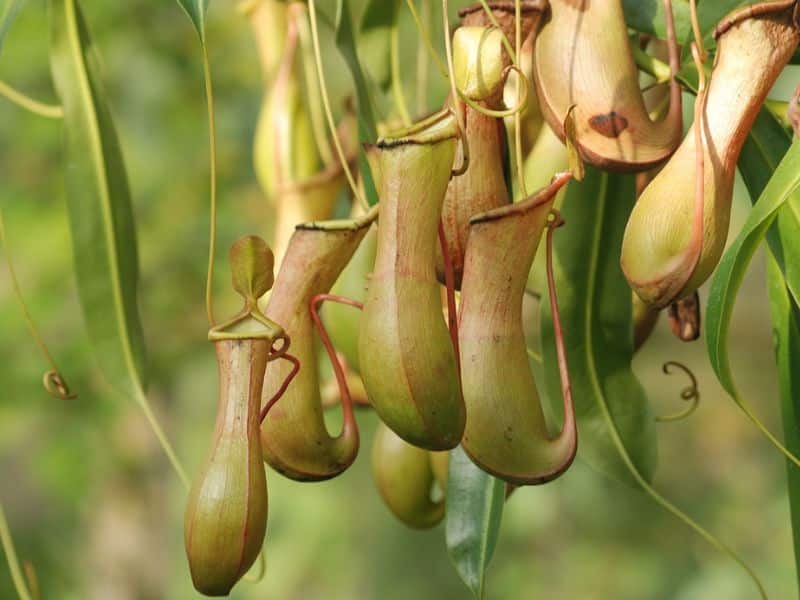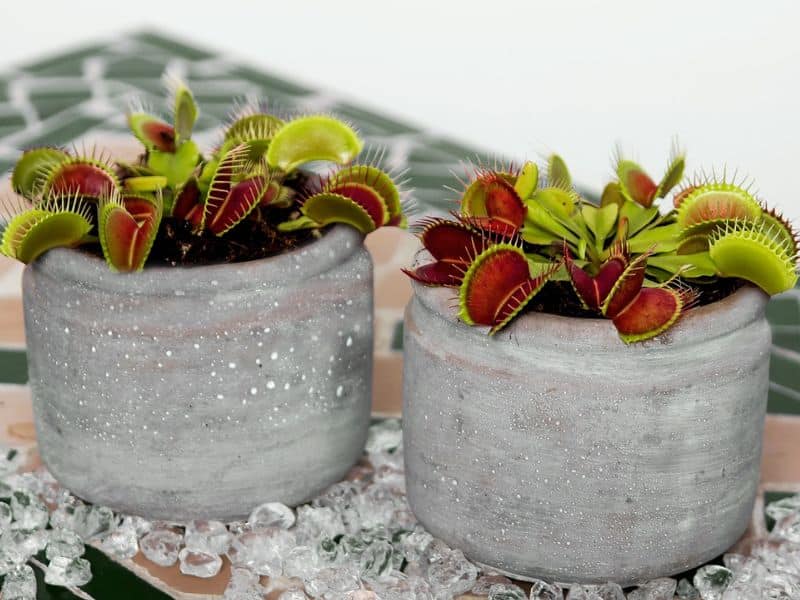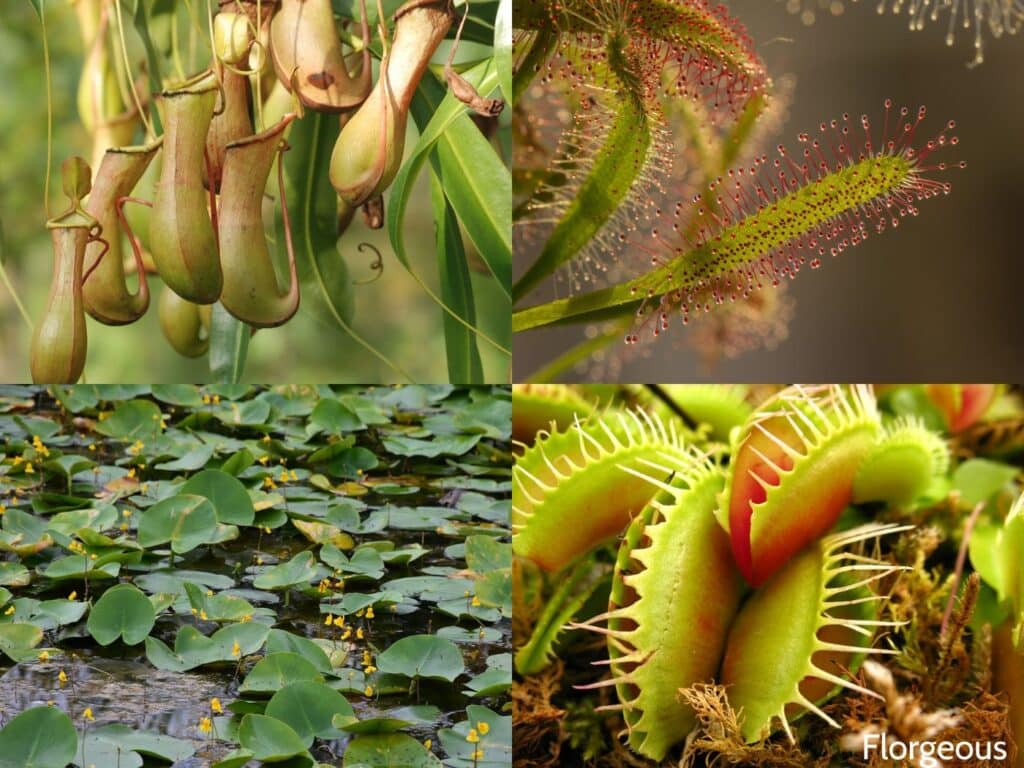Imagine walking through a lush, green forest, only to discover that it’s not just the animal kingdom that’s on the hunt. Yes, you’ve entered the intriguing world of carnivorous plants! These fascinating specimens have turned the tables on the food chain, making insects their main course.
From the infamous Venus Flytrap to the deceptive Pitcher Plant, these botanical wonders use a blend of cunning tactics and unique adaptations to trap and digest their unsuspecting prey.
Ready to delve into this captivating realm where plants become predators? Let’s explore the science and mystery behind these bug-eating marvels of nature.
Types of Carnivorous Plants
If your curiosity about carnivorous plants has been stoked, here’s a chance to explore. Let’s journey deeper and encounter some deadly, bug-eating flora you may well want in your garden.
1. Pitcher Plants: Nature’s Deadly Goblets

Fancy a botanical deathtrap? Try pitcher plants! These natural goblets are a nightmare for insects.
While its charming colors and delightful nectar attract thirsty bugs, the plant’s slippery rim throws them straight into a pool of digestive enzymes. Yep, they’re drowned alive and broken down for the plant to absorb. Ruthless, isn’t it?
2. Venus Flytraps: The Rapid Snap Traps

Admired for their perfect bug-catching mechanism, Venus Flytraps are truly nature’s swift predators. Lured by the plant’s sweet aroma, its prey lands on one of the lobes, triggering tiny hair-like sensors.
Two touches within 20 seconds and snap— the trap is closed, leaving the unsuspecting bug inside to become a plant’s lunch.
3. Sundews: The Sticky Assassins

If you think carnivorous implies quick action, sundews may well make you reconsider. These plants use a ‘slow but steady wins the race’ approach.
Their leaves spread out covered in sticky dew-like droplets, ideal for catching unsuspecting bugs. Trapped by the gluey substance, bugs struggle and only entangle themselves further, while the plant leisurely starts its digestive process.
4. Bladderworts: Aquatic Insect Trappers

Living proof that charm can be deadly, Bladderworts are aquatic carnivorous plants. The question is, how does a water-dwelling plant trap insects? The answer: ingenious underwater ‘bladders.’
This smart trap uses a pressure difference to suck in mini critters swimming by. The trapdoor closes in a millisecond, leaving the poor bug with no escape route. Fascinating, isn’t it?
Habitats of Carnivorous Plants
While reading about these fascinating bug-eaters, have you ever wondered where they live? Let’s explore the diverse habitats that these unique plants call home.
Tropical Rainforests and Carnivorous Plants
In the dense, humid, and bustling world of tropical rainforests, carnivorous plants thrive. Why? It’s because these regions provide them with two conditions they crave: high moisture levels and a varied buffet of insects.
So, when you venture into a tropical rainforest, you may spot the notorious Pitcher Plants hanging from branches, waiting hungrily for bugs that dare to venture too close.
North American Bogs and their Carnivorous Species
Away from the tropical vibrancy, carnivorous plants have claimed North American bogs as their hunting grounds.
These wet, marshy areas are known for acidic soil, and guess what? It’s perfect for bug-eating plants. Plant species like the Venus Flytrap and Sundews flourish here, turning these seemingly tranquil bogs into arenas of insect entrapment.
Mechanisms Behind Bug Consumption
Let’s dive deeper into the intriguing world of carnivorous plants, observing how they ensnare their prey and digest them.
How Carnivorous Plants Trap Their Prey
Carnivorous plants have developed various effective strategies to capture their bug meals. Venus Flytraps, for example, rely on speed.
They’ve modulated snap-trap mechanics, luring insects with sweet-smelling nectar. Trigger hairs inside the trap sense the movements of an unsuspecting insect, and in less than a second, the trap snaps shut, entrapping the victim.
Conversely, you have Sundews and Pitcher Plants, which rely more on strategy than speed. Sundews have tentacle-like glandular hairs covered in a sticky substance. It may well appear like an inviting droplet of water to an insect, but contact with it results in a slow, sticky death.
Conversely, Pitcher Plants have evolved pitcher-like modified leaves filled with a digestive fluid that insects find irresistible. A precarious perch on the plant’s rim becomes the pitfall as insects slide down into the enzyme-filled pit, from which escape is impossible.
Lastly, let’s not forget aquatic Bladderworts, showcasing their prowess underwater. They employ vacuum-driven traps that suck in tiny water invertebrates when triggered, all in a fraction of a second.
Digestive Processes in Carnivorous Plants
Once the prey is secured, the digestive process starts in earnest in these fascinating carnivorous plants – a process quite similar to us mammals!
Venus Flytraps encapsulate captured insects inside their trap, secreting enzymes that slowly break down the victim into a nutrient soup absorbed by the plant’s tissues. The same goes for Sundews, albeit their sluggish prey entrapment process pairs with a slow digestion cycle, resulting in a longer extraction period.
Pitcher Plants, conversely, let their captive insects drown in the digestive fluid found at the bottom of their pitcher – a trap that also serves as a stomach. Gradually, the insect’s body dissolves in that fluid, with nutrients being absorbed by the plant through specialized cells lining the pitcher’s walls.
Bladderworts, the speedy trappers of the water world, also work swiftly with digestion. Once the prey gets sucked in, so does the water, triggering the release of digestive enzymes. This process quickly reduces the captured prey to a digestible sludge, proving these plants as efficient at digestion as they are at trapping.
Benefits of Having Carnivorous Plants
There is more to carnivorous plants than their skillful trapping and devouring of bugs. The presence of these natural predators can offer surprising benefits in both aesthetic and practical ways. This section delves into the advantages of having carnivorous plants in your surroundings.
Natural Pest Control Benefits
Loathe swatting mosquitoes? Fed up with flies? You’re not alone.
Carnivorous plants are your perfect partners in this matter. Acting as natural pest controllers, these plants efficiently trap and consume insects, reducing the number of pests in your environment.
Venus flytraps, for example, gulp down flies and mosquitoes in a snap, literally! Pitcher plants expertly attract and ensnare all sorts of pesky creatures. So, if you’re looking to ditch harsh chemical bug killers, think about inviting these helpful plants into your space.
Caring for Carnivorous Plants at Home
Congratulations! You’ve entered the intriguing world of bug-eating plants. Let’s learn how to keep them thriving at home.
Optimal Soil Conditions
You can’t feed a carnivorous plant with any old dirt from your backyard. They fancy a distinctive mix, often poor in nutrients but decked with peat moss and perlite.
Often gardeners prefer a 50-50 mix of these. The key is to avoid nutrients rich in soil, as these can have a toxic effect on your new plant compatriot.
Watering Requirements: Keeping the Balance
These plants demand a bit of a juggling act when it comes to hydration. Carnivorous plants love water, but not too much. The rule of thumb is to keep the soil damp but not waterlogged. It’s best to use distilled or rainwater, as tap water could contain minerals that are harmful to them.
Sunlight and Temperature Needs
Carnivorous plants may well eat bugs, but they also need their fair share of sunshine, just like any other garden dweller. They generally favor full to partial sunlight. As for the temperature, they appreciate a cooler climate, somewhere in the 70-95 °F range during summer and around 55 °F in their winter dormancy.
Navigating these intricacies may well seem a tad daunting at first, but with a little patience, you’ll have a thriving mini ecosystem right at home.
See more:







